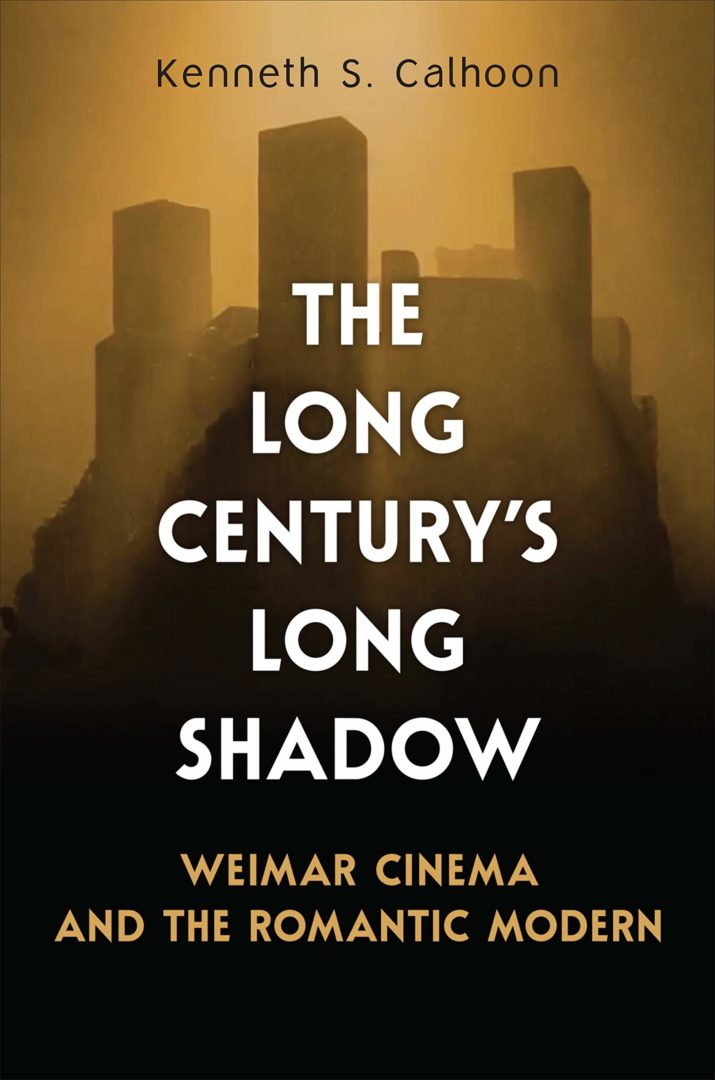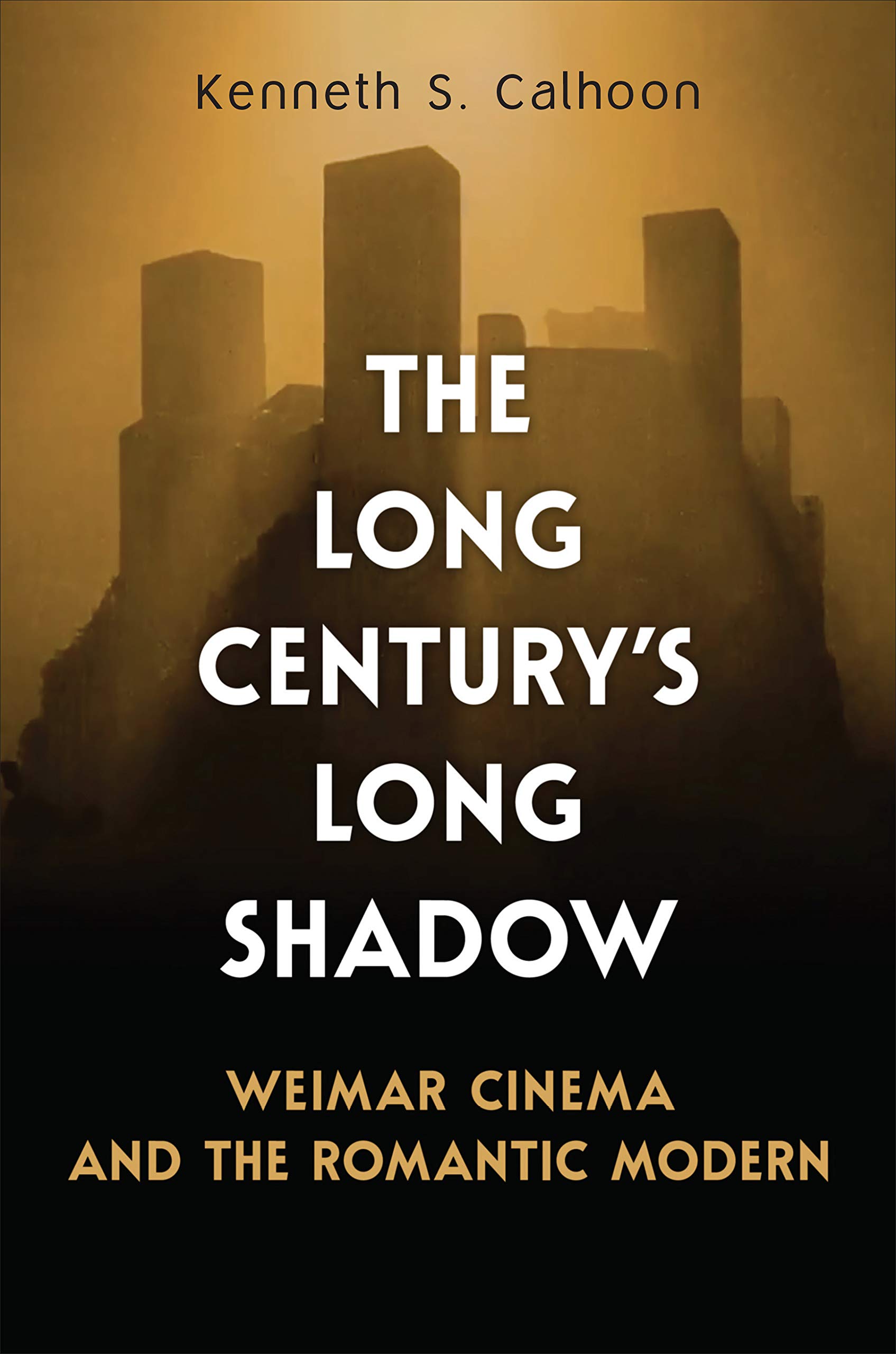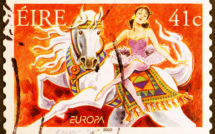
The Long Century’s Long Shadow: Weimar Cinema and the Romantic Modern by Kenneth S. Calhoon

Kenneth S. Calhoon’s exciting new study links the cinema of Germany’s Weimar era (1918–1933) to previous aesthetic traditions. Commonly referred to as “the golden age of German cinema,” the Weimar era is affiliated with various cinematic innovations underpinning popular and arthouse cinema cultures that influenced international filmmaking in various ways (Kaes, Jay, and Dimendberg 1995, 617). Although certainly interested in how iconic films of the era informed filmmaking praxes that came after it, Calhoon’s book is primarily concerned with Romantic tendencies in Weimar cinema, establishing comparative links between aesthetic concerns arising around 1800 and those of the 1920s.
The Long Century’s Long Shadow sits positioned in a long line of similar comparative approaches. In fact, it advances concerns raised in the most famous early associative analysis between Weimar cinema’s stylistic preoccupations and those of Romanticism—namely, the film critic Lotte H. Eisner’s monograph titled The Haunted Screen: Expressionism in the German Cinema and the Influence of Max Reinhardt (1952). A particularly evocative discussion from Eisner’s book pertains to a cross-examination of Weimar film and Romantic literature that Calhoon variously takes up throughout his analysis. In Eisner’s work, the ominous description of Coppelius from E.T.A Hoffmann’s Der Sandmann (“The Sandman,” 1817) aligns with that of Dr. Caligari from Robert Wiene’s Das Cabinet des Dr. Caligari (1920); the stranger from Jean Paul’s Titan (1803) bears uncanny similarity to the physical appearance of Count Orlok in F.W. Murnau’s Nosferatu (1922); and the archivist Lindhorst from Hoffmann’s Der goldene Topf (The Golden Pot, 1814) not only glides but then transforms into a bird in a gesture that resembles Scapinelli’s magical tricks in Henrik Galeen’s Der Student von Prag (The Student of Prague, 1926). Moreover, Eisner describes a passage from Jean Paul’s Flegeljahre (The Awkward Age, 1804–05) as proto-cinematic. In it, “the flowers became trees, then changed into columns of cloud; and at the tops of the columns flowers and faces grew” (Eisner 2008, 113). Such blurring of boundaries, which Eisner also identifies as a feature of select scenes from Novalis’s Heinrich von Ofterdingen (1802), for her anticipate cinematic editing techniques. The analysis ultimately leads Eisner to conclude that “German cinema is a development of German Romanticism, and that modern technique merely lends visible form to Romantic fancies” (113).
The Long Century’s Long Shadow is best characterized as taking such Eisnerian associative comparisons between Weimar cinema as an artform and German Romanticism to a new level. The book indeed covers an incredible range. It not only brings literature in conversation with cinema, but also draws on discourses in philosophy and art history, insights from poetry and visual culture, and frameworks inspired by psychoanalysis and psychoanalytic film theory. For Calhoon, central aesthetic principles from German Romanticism not only help generate a better understanding of how these inform iconic films from the Weimar era, but the inverse is also the case. The Romanticism/Weimar cluster forms a type of generative reciprocity that—in the form assessed in Calhoon’s book—aims to strengthen our understanding of how both traditions were constituted by a similar rejection of neoclassicist iconography. In this regard, Romantic and Weimar cultural products index a commitment to animation, vitality, movement, and other related operations that destabilize the position of the subject they engage. As such, Calhoon expands on the purview of studies such as those conducted by Eisner with a complex set of analyses that probe, among other, the capacity of audience perception in the context of elaborate landscape settings, shifting visual arrangements, or otherwise dreamlike sequences.
In his discussion of Heinrich von Ofterdingen, for instance, Calhoon extrapolates the cinematic capacities of the dream sequence in which the famed blue flower of Romanticism appears to the protagonist. Like Eisner, he views the scene’s narration of porous transitions across scenarios that give the impression that they bleed into one another, using techniques analogous to those of cinematic super-imposition. Reaching beyond Eisner’s comparison, Calhoon links the analogy to a discussion of how the novel’s protagonist is sutured into the dream-space of the scene itself. Heinrich, as entwined with the setting he traverses, comes to experience it sensorially in all its wondrousness; but, in so doing, he also comes to become hyper-receptive of his position in the experience itself. On the one hand, the subject’s immersion anticipates various post-Romantic aesthetic technologies. As Calhoon notes, the dream sequence of Novalis’s protagonist “looks forward to those attractions alongside which the earliest motion pictures were shown, and which the cinema has almost habitually incorporated as a way of figuring its own prehistory” (56). The glimmering lights of the attractions draw spectators’ attention, nearly forcefully demanding to be apprehended. On the other, it also helps cast into sharp focus some of the operations at the core of an iconic example from Weimar cinema: Alan’s death following the spectacle of Cesare’s premonition in Das Cabinet des Dr. Caligari. In being subjected to the mesmerizing (and agonizing) performance of Cesare’s divinatory gifts, Alan is so enamored by the event that he fails to take note of a rival: his friend Francis, whose “silhouette loom[s] on the wall above his victim’s bed” in Alan’s death scene, recedes into the background as his culpability dissipates (64). Fused with the dream space of Dr. Caligari’s performance, Alan’s hyper-receptivity of the spectacle ultimately becomes his undoing.
The most impressive analysis in the book relates to Romantic painting, in particular the work of Caspar David Friedrich. Here, Calhoon engages an analysis of how image composition relates to the landscape. Friedrich’s The Monk by the Sea (1810), which famously depicts a tiny figure exposed to the terrifying vastness of the landscape in which it is positioned, presumes a static viewer. The viewer, in apprehending the vastness, cannot but scan the large canvas from side to side, as though “panning” from one position to another. Drawing on the insights from the art historian Wilhelm Worringer, Calhoon notes that the movement of the viewer’s relation to the content of the painting itself “reduc[es] its depth, and thereby heighten[s] the subject’s confrontation with the Absolute” (33). Such exciting deployment of cinematic terminology affords Calhoon the chance to assess an affective consequence of Friedrich’s painting, which itself relates to quietude, but also helps sharpen a method about how to approach vast landscape analysis in cinema. Here, the longshot landscapes of Fritz Lang’s Siegfried (1924), shot with a stable camera, can be approached with the same type of dynamism of an imagined “pan” even when this is not actually formally present in the film.
Cinema scholars reading Calhoon’s book might be disappointed in the very framing of his undertaking. In foregrounding aesthetic qualities that cinema shares with other discourses, the study does not allot space to acknowledge nor aims to explore the specificity of the cinematic medium. Even the recourse to psychoanalytic film theory itself serves as means to link cinematic concerns to those affiliated with Romanticism. Calhoon even distances himself from media theory with disclaimers such as these: “Whether everything in cinema is truly based on machines is debatable” (85). This, to me, seems like a missed opportunity to use cinema’s media-specificity to connect the insights in his study to related scholarship on Weimar cinema. Steve Choe’s Afterlives: Allegories of Film and Mortality in Early Weimar Germany(2014) offers a fruitful avenue in this regard. The study details how Weimar cinema’s intellectual commitment to animation itself reflects a type of medial awareness of its own technological capacities that aligns with some of the claims Calhoon advances about aesthetics.
Admittedly, I remain hesitant to suggest the study engage with more scholarship than it already does for the mere reason that its denseness at times poses reading challenges to even informed readers. Although broken up into an introduction and seven chapters over the course of some 200 pages of text, each chapter contains reflections about Romantic philosophy, literature, poetry, sometimes shifting focus points from one paragraph to the next. Indeed, it is surprising that such a dense study lacks a proper conclusion that would help offer some stability to what might otherwise be read as at times loosely connected reflections. In this regard, the study would be of interest to advanced scholars of Weimar cinema well-read in the German and European aesthetic traditions of the nineteenth century. Its richness demands a patient reader, but one who will no doubt be left inspired by what comparative media studies affords to cinema studies.
Ervin Malakaj is assistant professor of German studies and affiliate faculty in the Centre for European Studies at the University of British Columbia. Next to articles and chapters on media studies and queer film studies, he has co-edited three volumes on topics ranging from nineteenth century literary studies, interdisciplinary approaches to slapstick, and critical approaches to German studies.
The Long Century’s Long Shadow: Weimar Cinema and the Romantic Modern
By Kenneth S. Calhoon
Publisher: University of Toronto Press
Hardcover / 288 pages / 2021
ISBN: 9781487526955
References
Eisner, Lotte. 2008. The Haunted Screen: Expressionism in the German Cinema and the Influence of Max Reinhardt. Translated by Roger Greaves. Berkeley: University of California Press.
Kaes, Anton, Martin Jay, and Edward Dimendberg. Eds. 1995. The Weimar Republic Sourcebook. Berkeley: University of California Press.
Published on November 9, 2021




